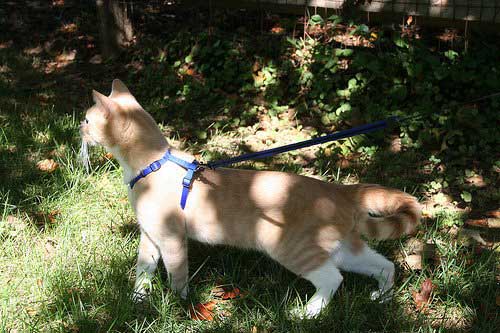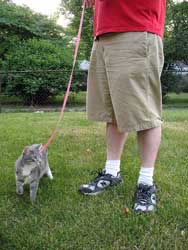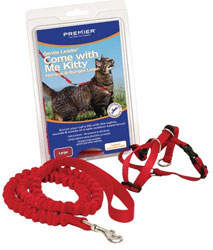Cat Leash Training
Cat Training To Keep Your Cat Safe Outside
Cat Leash training may be something you have never thought of, mainly because you don’t think it is possible to train your cat to walk on a leash.
Even I had never heard of it until a couple of years ago, when my sister told me she was training her cat to walk in the garden with her as he was scared to go outside on his own.
I think I remember laughing at the time, as I thought this was impossible. How wrong was I? She managed to train him and help him find his confidence and now he is happy to be outside.
Training cat walking on a leash is of course not something that needs to be done for all cats but there are circumstances where it would give your cat freedom whilst staying safe. Perhaps you live near a busy road or like my sister have a nervous cat for instance.
Why Consider Cat Leash Training?

There may be a variety of reasons why you would consider cat leash training for your pet. My sister’s was that her cat was very nervous of going outside, even though he obviously wanted to, and cat leash training seemed like the perfect solution.
Other reasons might be that you are worried about traffic in your area or even that you know some of your neighbours don’t take too kindly to cats in their gardens.
Safety is obviously the main reason for cat leash training, We have been very lucky up to now with where we live. It is not an area where I am concerned about my cat’s safety when they go out. But some people live where it would be impossible to let a cat roam outside alone.
Your Cat Is Not A Dog
The first thing to remember is that cat leash training will not have the same results as if you were training a dog. For instance, not many cats will trot happily next to you as you walk along.
In fact they will probably just meander around, stopping all the time to investigate a new item or smell. That’s what cats do and you won’t change that; why would you?
The best way to look at cat leash training is that you can be outside with your cat, giving them the freedom to enjoy the outside, in the safe knowledge that no harm will come to them. Just let your cats do their own thing and follow at the other end of the leash.
The Equipment
One of the most important things to start with in cat leash training is to make sure that you have the right equipment.
It will be uncomfortable and possibly unsafe for your cat and also it will be seen as a bad experience which will not encourage your cat to learn this new behavior.
Collars : Don’t be tempted to use a collar for cat leash training. Your cats neck is much more delicate than a dogs and you are more likely to cause an injury. They are fine for every day wear but not for cat walking.
Harness: The best solution is to buy a special cat harness. They come in a couple of different designs, one a figure of 9 the other a H harness.
The harness fits around the middle of the body and shoulders. It should not be too tight, but not so loose that the cat will be able to wriggle out of it.
Leash: The leash fits into a metal ring on the back of the harness, so that when you tug at the leash it pulls at the chest. This will not hurt and will be a firm instruction from you to the cat. The leash should be lightweight and fairly short, 6 feet the maximum length.
Cat Leash Training Tips
Of course the younger your cat is when you begin the training the better. A kitten will treat the training as a fun new adventure and is more likely to get used to the leash much quicker. But don’t worry if your cat is older, my sisters cat was about 7 when they trained him.

- Step 1. Let your cat get used to the harness before you try to put it on them. Leave it near their sleeping place for a few days and rub their scent onto it, so that at least it smells like a familiar object.
- Step 2. In the house, put the harness on your cat just before their usual dinner time. Then as soon as it’s on, make a big fuss of them and give them their favourite dinner.
- Step 3. Let them walk around with the harness on for a while after dinner. If they seem unhappy about the harness try to distract them by playing with them and praising them when they leave the harness alone. Do not shout or scold your cat if they try to get out of the harness.
- Step 4. Attach the leash and let it drag behind your cat for a while, letting them go where they like. It’s all about getting them use to the new equipment before you begin the actual cat leash training.
Carry out the above steps everyday for about a week or until your cat pays no attention to the harness and leash.
It is best to pay attention to how your cat reacts to the harness and wait for them to accept it. If you try to rush things it just won’t work. My sister made the mistake of trying to take her cat straight outside with the harness first day. You should have heard the hissing.
- Step 5. Once they are happy wearing the harness it’s now time to get them used to you following them around. Pick up the leash (still indoors), but keep it slack and follow them around like this for a while. Once again repeat this process for a few days.
- Step 6. Now, while holding the leash, call your cat and encourage them to come to you. Do not pull on the leash as this will make your cat pull away rather than come to you. The aim of this is to get your cat to follow you.
- Step 7. Now that your cat will walk with you on the leash it’s time to take them outside. Make sure that the first few times you take them outside you let your cat decide how far they want to go.At first they might just be happy to be with you near the door. But as they become more confident, you can gently persuade them to follow you further out. Remember to never pull on the leash and keep it fairly slack, but not too long as you may need to be close enough to rescue your cat from any dangers.
Take your time with this cat leash training. If it turns into a battle of wills, you will surely lose. Remember cats learn by experience, so make this a good one from the start.






